Which of these rounds are worth a shot?
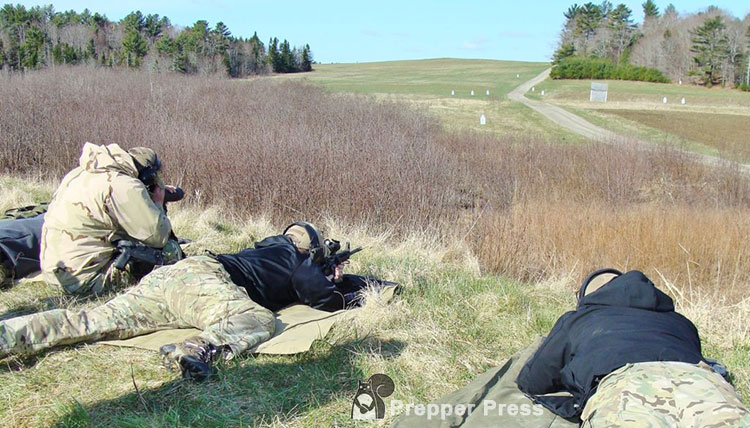
There is a lot of confusion around these rounds: M193 vs M855 and then vs .223. Most folks realize the 5.56 NATO is synonymous with the U.S. M16A1 Rifle. Nowadays, numerous other firearms use the same cartridge but the iconic black rifle of the Vietnam era really kicked it off. And, like many other firearms destined for hard knocks, there were early teething pains.
The original 5.56mm load was designed for the 20-inch barrel of the earliest carry-handle M-16s. The system’s straight-line function and fast lightweight projectiles minimized recoil to improve control, especially during full-auto fire. The concept proved successful as long as the rifle actually worked but, long story short, sometimes it choked. Changes in the M16A2 and subsequent rifles included the now common forward assist, and a propellant less likely to produce fouling with that era’s lubricants.
Before we get into the article, know that there are numerous different cartridges/loads referenced. Below is a table outlining all of the loads to make it easier for the reader cost compare or gain more information on each:
| Cartridge | Manufacturer | Retailer |
|---|---|---|
| 5.56 XM855 | Varies | Brownell’s, Guns.com, Lucky Gunner, Palmetto State Armory, Sportsman’s Guide, Sportsman’s Warehouse, Optics Planet |
| 5.56 XM193 | Varies | Brownell’s, Guns.com, Lucky Gunner, Palmetto State Armory, Sportsman’s Guide, Sportsman’s Warehouse, Optics Planet |
| .223 55 grain FMJ | Federal American Eagle | Optics Planet, Palmetto State Armory, Sportsman’s Guide |
| .223 55 grain Ballistic Tip | Federal | Optics Planet, Sportsman’s Guide |
| 55 grain GMX lead free | Hornady | Sportsman’s Guide |
| 55 grain Barnes TSX | Federal | Optics Planet, Sportsman’s Guide |
| 60 grain Nosler Partition load | Federal | Optics Planet, Palmetto State Armory, Sportsman’s Guide |
If it’s primarily M855 vs M193 that you are looking for, see our Bulk Ammo Deals page for buying in larger quantities. It is updated weekly.
The 5.56 M193 Load
To begin the M855 vs M193 discussion we start with the M193, because that came first.
By the time I commenced an extended Southeast Asian vacation to Vietnam, the M16’s bugs had been worked out. It ran reliably with proper maintenance but, other than a powder switch, the cartridge itself was unchanged. Designated as M193 cartridge, it’s metrics work out to 5.56x45mm. The projectile was a .224 (.22-caliber) full metal jacket boattail, which weighed 55 grains. Muzzle velocity was listed at around 3160 feet per second (fps).
Lethality of this load was somewhat in question, misinformation aside. Cutting to the chase, the 5.56mm is darn close to the .222 Remington, which appeared in 1950 as varmint cartridge. It proved to be a huge success and also gained quick favor with benchrest shooters. The next evolution was the somewhat faster .222 Remington Magnum; a close relative of the military 5.56 cartridge.
Interestingly, Remington never pitched these calibers as big game loads. Their forte was always varmints like prairie dogs, woodchucks, or coyotes, etc. Same story for the .223 Remington; a civilian version of the 5.56 M193. Suddenly the expectation was the latter could neutralize two-legged threats. And, sometimes it did.

M193 Bullet Stories vs Experience
Stories I heard involved everything from the mysterious new M16 bullet entering a knee and coming out an elbow, to the tumbling-bullet phenomenon. Firsthand experience was more educational. Beyond being .22-caliber, the bullet itself was fairly fragile, and soldiers carry lots of metal gear; pack-frames, canteens, entrenching tools, and magazines, etc. These items can disintegrate or deflect projectiles to strange angles. The tumbling effect, although real, was by no means guaranteed, and some wounds were straight pass-throughs. However, contact typically occurred at close range, accompanied by a barrage of full-auto bullets that could offset most deficiencies (we still call this “spray and pray”).
M193 Terminal Effects
As for terminal effects, it’s worth noting the effects of rifling, which spins bullets at truly awesome RPMs. Given the tremendous centrifugal force, it doesn’t take much to unravel a small, thin-skinned bullet!
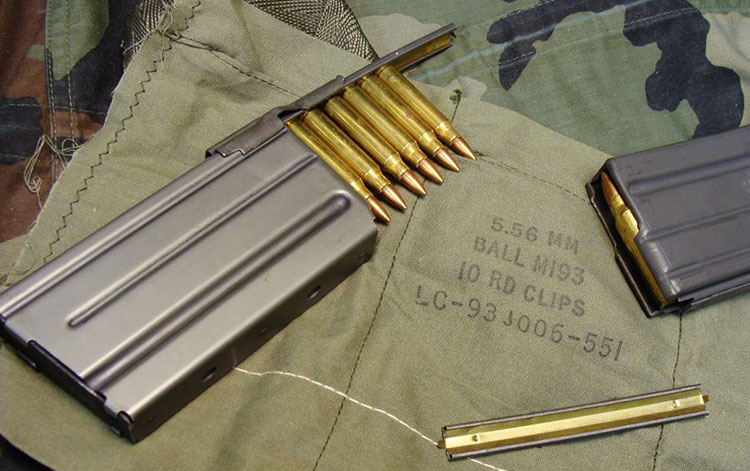
Of course, the main purpose of rifling is to spin a bullet on a stable axis. The original twist of 1:12 (one turn per foot) was deemed optimal for this purpose using 55-grain M193 Ball. Decades later I special-ordered a 24-inch HB AR15 with the same 1:12 twist for use with lightweight 40–55 grain varmint bullets. My main goal was accuracy, but larger critters and two-legged threats really require more clout – even if they’re not wearing steel helmets.
The 5.56 M855 Load
The 1980s saw a move toward standardization of NATO ammunition, concurrent with new or modernized small arms. U.S. forces saw adoption of a 9mm NATO pistol (the M-9 Beretta), and upgrades to the M16. Recognizing the shortcomings of the original 5.56 load, a heavier MK-855 “green tip” was adopted.
The 62-grain FMJ projectile incorporated a steel penetrator to help drill steel-hat threats out to 600 yards or so. Although starting slower at around 3000 fps, its extra mass did improve longer range performance. Some lump accuracy into this “improvement,” but it’s a bit more complicated than that.
Just about all of the bullet makers struggle to achieve stellar accuracy from composite-core bullets. Concentric inserts are difficult to produce and it only takes a tiny deviation to impart downrange yaw. Composites are also longer than standard lead core bullets, so like other long or heavy-for-caliber projectiles, they require faster rifling to stabilize. To address these issues, a much quicker 1:7 twist was adopted.
What is the M855 Good For?
Despite its steel insert, M-855 green-tip is not a true armor-piercing round. However, it can wreak havoc on reactive steel targets now seen with increasing frequency. It’s also not a hunting load, since it’ll act more like a drill in soft tissue. So, what’s it good for beyond hardened targets? From a civilian viewpoint, the M855 is mostly good for punching holes in paper.
M855 vs M193 – Which is Best?
As for which one is best? My choice is neither. Instead, I’ll be shopping for some good .223 loads. The first pick will be fairly affordable, and it’ll have much in common with M193.
M193 and M855 notes: One advantage to both loads is that they are waterproofed with sealed bullets and primers. The primers are also crimped into their pockets for fast-cycling reliability. When the chips are down they’ll function, which could be of paramount importance. The equivalent civilian version of M193 load is Federal’s 5.56 XM193, 55-grain American Eagle. Supposedly, it comes off the same line as similar military loads, sealed, with crimped primers.
.223 Remington Alternatives
Most shooters know the .223 Remington is a follow-up civilian version of the 5.56×45. Some consider the 5.56 and .223 loads interchangeable, but that’s really not the case. Of the two, a .223 has a tighter chamber. It’s also loaded to lower pressures. Thus, a roomier 5.56 chamber can safely fire a .223 Remington cartridge. But shooters who reverse this process can encounter unsafe chamber pressures!
If yours is a .223 chamber the decision becomes easy regarding M193 or M855. The correct choice is neither. No worries though. We can do better – even if you have a 5.56 NATO rifle.
Rather than fret over heavier bullets, how about going with one weight that can cover most needs through a common zero? For many of us, the needs will include plinking, defense, varmints, or possibly even deer (if lacking a larger caliber). Turns out, although considered light, carefully chosen 55-grain bullets can cover most. Today’s various rifling twists are also factored in.
.223 Practice, Plinking, and Even Small Game Loads
I’ve been using .223 Federal 55-grain American Eagle FMJ for years. It was my agency’s Q-load so I bought it by the ton (literally). It’s no more match-grade than other military-type loads, but it’ll cover most practice needs.
Our troops zero their Aimpoint-equipped 16” AR-15s at 50 yards, which puts them on the money again 200-yards. Rifled with 1:9 twists, these ARs average around 1.5–2 MOA. I’ve used the same AE FMJs in a European 12 Ga./.223 combination gun to pot the occasional small game dinner. Its 1:12 barrel is accurate enough (.75 MOA) to make head-shots. This load also shoots well in most 1:8 barrels.
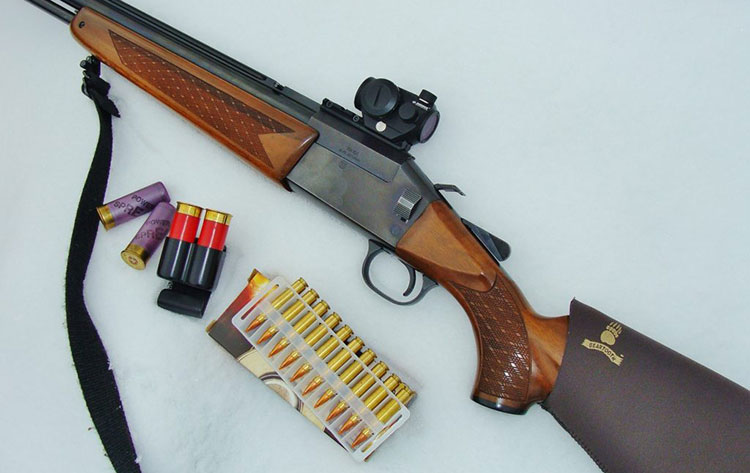
Just about every ammo manufacturer makes a 55-grain FMJ which is normally quite affordable. Of course, right now the hardest part is finding some.
.223 Varmints Below “Big Game” Status Loads
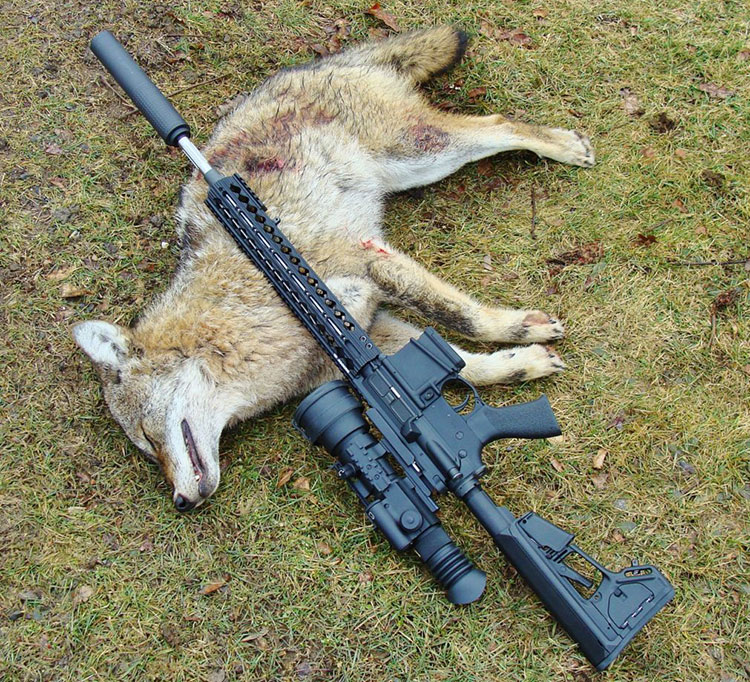
One sure-fire way to determine a load’s effectiveness is to use it on our Northern New England coyotes. Because these hybrids run big and tough due to gray wolf genes, anchoring one can be a challenge. I was about to switch to a .243 when an tactical LE connection handed me a box of Federal 55-grain Ballistic Tip .223 rounds (I’ve procured it since in LE and sporting boxes).
Now, many tough coyotes later, I can vouch for the effectiveness of this load. Although some Nosler BT iterations are reputed to be fragile, this .223 version behaves more like a miniature big game load. It reliably piles up 50-pound coyotes (or bobcats) while leaving a classic exit hole.
This stuff is accurate, too! I’ve seen frequent 0.35 MOA from a 1:8 Wylde Chamber, and steady 0.6 MOA from a Remington HB M-700 rifled 1:9. The list goes on, too. If nothing else was available I’d use this bullet for deer, shooting – carefully. Based on trusted LE reports, it should also work well for defense.
Federal sells their 55-grain sporting version as “Varmint and Predator Nosler Ballistic Tip.” It’ll usually impact close to Federal’s 55-grain AE load, which is good considering its cost. Like other premium-type loads, a 20-round box could set you back $30.
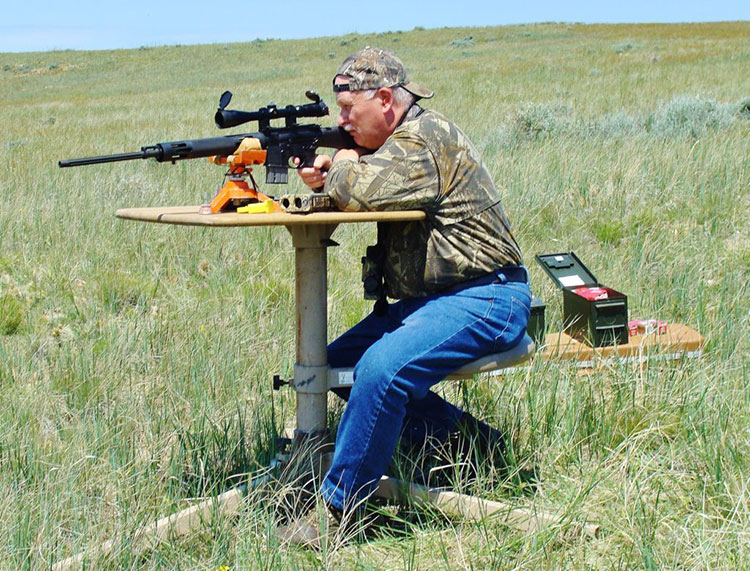
Light varmint note: I’ve fired vast quantities of .223 Hornady 55-grain TAP in 5.56 NATO, Wylde (hybrid), and .223 chambers. It’s my go-to load for maximum accuracy in various rifling twists. It also offers rapid expansion. During several prairie dog extravaganzas, sod poodles were break-dancing out to 500 yards. But, despite much low-angle shooting, ricochets were extremely rare – seemingly less so than .17 HMRs!
Hornady’s LE TAP load has a polymer tip and looks a lot like their varmint offerings. It could have some merit for defensive use in tight quarters where the main concern is overpenetration. But, for use against critters larger than foxes, I’ll go with a tougher bullet.
.223 Large Animal Loads
Instead of messing with a bullet insert, how about an all-metal projectile? Today’s solid-coppers offer the winning combination of extraordinary penetration, excellent expansion, and very good to stunning accuracy. Most of my experience involves Barnes TSX in various calibers.
Several years ago I was present for the testing of various handgun and rifle bullets, fired into gel-blocks, per FBI protocols. This event was hosted by a big-name ammunition manufacturer for LE firearms trainers. At its conclusion, a pair of end-to-end gel blocks were still sitting on a table so I broke out a box of Federal .223 55-grain Barnes TSX.
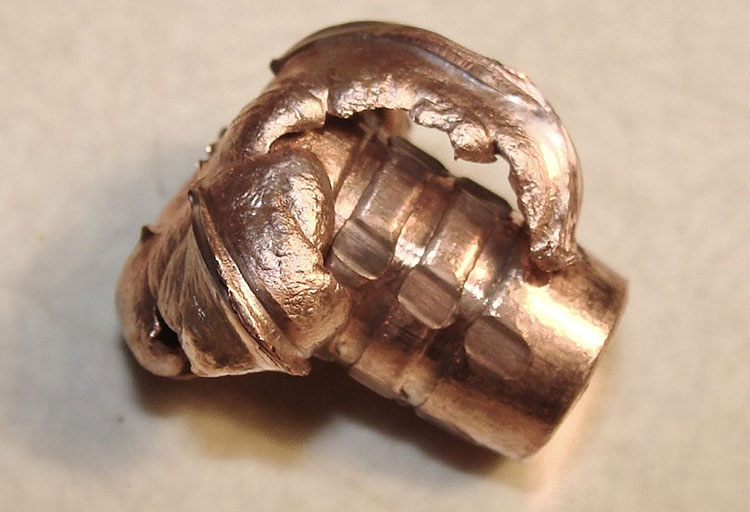
At that time, monolithic bullets were less understood. The manufacturer had no equivalent product and several attending state crime lab techs had little experience with them. I wish we could’ve recovered the TSX shot, but for all I know, it’s still going having emerged (quite literally) as the day’s penetration champ. However, it did leave a classic expansion signature before drilling through both blocks – the only load to do so!
Since then, I’ve witnessed similar results during formalized testing of Hornady’s similar 55-grain GMX solid-coppers. But, the majority of my experience pertains to deer; all cleanly harvested with Barnes TSX bullets in calibers ranging from .350 Rem Mag down to the small .300 Blackout (110 TAC-TX version). Absent are .223 reports. Out of all such loads available, this 55-grain solid-copper Barnes would be my pick for deer (or hogs). However, I just go to a larger caliber.
.223 Defense Loads
Regarding defense, the big concern for civilians could be excessive penetration. As for accuracy, Barnes TSX results can be phenomenal – usually. But, some barrels outright hate ‘em. A monolithic will be longer than an equivalent lead bullet so, theoretically, it should like faster twist rates. Maybe, but my 26-inch HB Remington M-700 .223 produced ½ MOA groups despite its 1:12 rifling.
My Wylde-chambered 1:8 did 1.25 MOA, still useful but not spectacular (I swear there’s some voodoo involved with twist rates). Anyhow, the proof is in the shooting. This stuff is expensive but, if POI is consistent with FMJs, you probably won’t need as many.
The big takeaway: Despite typically classic expansion, a solid-copper bullet like the Barnes retains nearly all of its mass for deep penetration. That kind of performance should bump you up at least one weight class, often without the need to re-zero. Assuming POI is consistent with other 55-grain loads, much of its cost can be amortized.

Heavier bullet option: Check out Federal’s 60-grain Nosler Partition load. The bullet is well-proven choice for hunting, and the .223’s version shoots accurately in most rifling twists. It hammers big coyotes as well as a 55-grain Nosler BT and, for whitetails (or hogs), it could be the better choice.
M193 vs M855 vs .223 Alternatives Summary
Ever since its appearance, efforts have been underway to make the 5.56 NATO something it really isn’t; a reliable big game cartridge and decisive fight-stopper. Hence, the appearance of numerous 6.5s, the .30 AR, .350 Legend – and many others. But, bullet design does matter, and it is possible to give .224 projectiles a bump through carefully chosen projectiles.
Really, the M855 vs M193 debate should not be had without considering .223 alternatives.
High Power competitors have moved to VLD projectiles to boost downrange performance of their service-type ARs at 600 yards. These low-drag .224 bullets, being ultra-heavy, won’t stabilize without the fastest twist-rates. Although more wind resistant, good calls are still a product of experience. For the rest of us, 400 yards is a pretty good poke with anything, especially in a breeze.
Like many others, I enjoy ringing steel targets at much further distances – after a switch to a larger and more suitable caliber. Although I still get my share of marginal hits, the suffering is confined to a bruised ego.

5 comments
i love this wonderful article
Excellent article. Thank you!!
“Our troops zero their Aimpoint-equipped 16” AR-15s at 50 yards, which puts them on the money again 200-yards. Rifled with 1:9 twists, these ARs average around 1.5–2 MOA.”
No, no, and no. Military zero’s at 25/300 meters. Military has never used 1:9 twist, that is strictly civilian. M16A1 was 1:12. M16A2 was 1:7 as is the M4.
Frank, pretty sure Steve is referring to the “troops” within the law enforcement-type agency he trains, not military troops.
The difference is in 1957 Gen. Willard G. Wyman wanted Eugene Stoner to create a smaller version of the AR-10 after it failed the CONARC testing trials from being sabotaged, the U.S. military and Stoner wanted a fast .22 caliber rifle projectile, but nothing that would wear a barrel out like .220 Swift, but nothing existed at that time so Eugene went to Sierra bullets, Winchester Ammunitions, and Remington and the .222 Remington special was created and later renamed .223 Remington because there was a lot of .222 cartridges on the market and they didn’t want to add to the confusion, the military secretly tested the AR-15 in Vietnam for a few years in small special operations and airborne units after Gen. Curtis LeMay played around with it at Fairchild CEO Richard Boutelle’s Birthday party in 1960 renewing more interest in the rifle for Air Force security units push for it’s adoption, in November of 1963 the AR-15 was adopted by the U.S. military, the U.S. Army and Marines version is called the XM16E1 and the U.S. Air Force version was the M16, the difference is the XM16E1 (Colt/Armalite 603) has a forward assist and the M16 (Colt/Armalite 604) did not, the .223 Remington ammunition was adopted and designated 5.56x45mm Ball M193.
.223 Remington is 5.56x45mm but it’s not to be confused with 5.56x45mm NATO ammunition they are the same diameter bullet but slightly different diameter cases, 5.56x45mm NATO ammunition was created in the late 70’s around 1976-1977 by FN Herstal in Belgium after NATO nations wanted a common ammunition for all NATO nations to use with ease in their weapons, they tested several firearms platform and ammunition calibers and settled for the .223 Remington but they wanted upgrade and improve the .223 Remington performance so that it worked reliably in all NATO nations weapons platforms and this is how 5.56x45mm NATO was born, .223 Remington was never created with hunting intentions it’s a military cartridge from it’s birth and so many people keep referring to it as it was developed for hunting varmint, wild hogs, and deer, the ammunition was created at the request of Eugene Stoner and the U.S. Government, it didn’t exist prior to the creation of the AR-15 and the AR-15 was created for the military and redesignated XM16E1 it was never sold as a sporting rifle before it’s adoption by the U.S. Government, the AR-15 was adopted by the U.S. military November of 1963 and redesignated XM16E1 and M16 depending which variant that you had, Colt owns the name AR-15 and decided to marketed it as a semiautomatic civilian sporting rifle called the Colt SP1 in May of 1964 which was seven months after the military already official adopted the AR-15 and redesignated XM16E1 after years or secret tests in the Vietnam Jungles.
5.56x45mm is the U.S. military designation for .223 Remington ammunition but it’s not FN Herstal’s 5.56x45mm NATO.
The first FN Herstal 5.56x45mm NATO ammunition was the SS109 cartridge, it has a mild steel core penetrator for defeating soft armor and steel helmets, the U.S. military adopted it in September of 1982 and redesignated M855 and nicknamed it green tip when the U.S. Marines adopted the M16A2 which has a 1:7 twist ratio barrel to stabilize the heavier 62gr. bullet which the M16A1, M16 and XM16E1 can not do with their 1:12 twist ratio barrels but the U.S. military approved the use of M855 in the M16A1 during emergencies but only at close ranges because the bullets would keyhole at distance.
I hope I really shined some light on this issue! I would also like to add